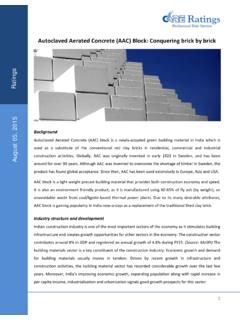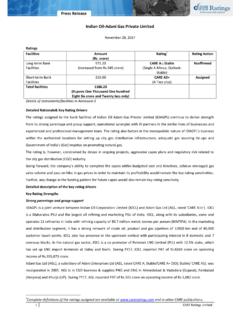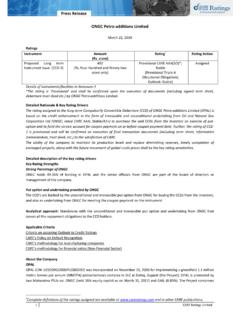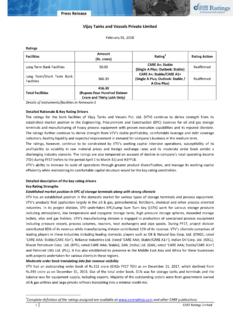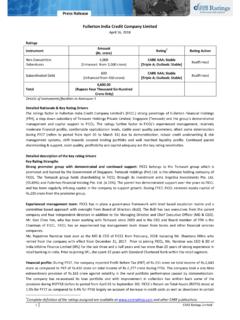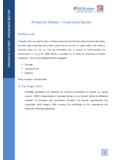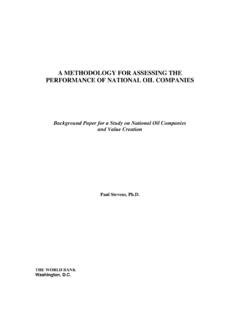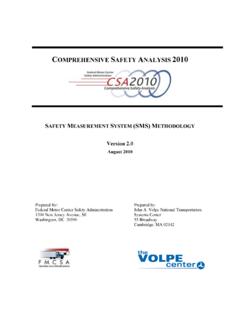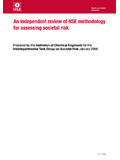Transcription of Rating Methodology: Factoring Linkages in Ratings
1 Factoring Linkages IN Ratings . Rating methodology : Factoring Linkages in Ratings (Parent-Subsidiary Link, Group Support, Government Support). Background The credit risk assessment of a corporate entity begins by analyzing the various risks (management, industry, business, financial, project risk) at a standalone level. While this would be adequate in many cases, there are situations where entities do not operate in complete isolation and exhibit Linkages with other companies and corporate entities. These Linkages often influence the credit profiles of individual entities and hence need to be analyzed while assigning Ratings to individual entities.
2 Such analysis is applied as a building block on top of the individual risk assessment and may result in either enhancement or lowering of Rating from the entity's standalone Rating . Further, there are situations which require taking a view on a group of related entities while arriving at individual entity Ratings . Apart from this, Ratings of entities which are supported directly or indirectly by the state or central government need to address the linkage with the government. This paper aims to highlight the situations under which such Linkages are analyzed and approach followed by CARE in each situation.
3 Broadly, CARE looks at three situations: - where the companies are linked through a parent-subsidiary relationship - a group of entities which collectively have management, business & financial Linkages - entities with direct or indirect support from the government The analytical approach followed in these situations is highlighted below. 1. Addressing Parent-Subsidiary Link in Ratings While assigning Ratings to a corporate parent company or its individual subsidiaries, a standalone view may not give the complete picture due the presence of Linkages between the parent and its subsidiaries. The Ratings of parent as well as subsidiaries are influenced by the individual credit profile as well as the nature and strength of these Linkages .
4 CARE examines these Linkages and factors it while assigning Ratings to the parent company as well as to the individual subsidiaries. The 1. Rating methodology : Factoring Linkages in Ratings approach followed for Rating a parent is highlighted below, followed by approach for Rating of subsidiaries. Rating of a Corporate Parent Company A corporate parent company can be categorized as per below. i. Corporate parent company having substantial business operations [Often the flagship company of the group or the main company of a business vertical of the group]. ii. Investment holding companies with no major business operations i.
5 Corporate parent company with substantial business operations Such companies are often the flagship companies of the group or the core company of a group in a specific industry segment. The corporate parent company is characterized by having a substantial portion of the group's business operations and often contributing to a large share of overall group's revenue, assets and profits. Over time, a company would expand its operations through organic or inorganic routes and would operate through various subsidiaries. The subsidiaries could be set up with various motivations as highlighted below: Operating as a backward/forward integration to the parent An extension of the parent in different regions and geographies A trading/marketing arm for parent's products & services Related diversification Setup with legal or tax motivations In such cases, a standalone view of the parent may not be sufficient to capture the risk presented by the subsidiaries.
6 Hence, CARE takes a consolidated view of the parent and its subsidiaries while assigning Rating to the parent company in such cases. An exception to this is when a subsidiary operates in a completely different business segment than the parent or if a subsidiary is of the nature of a Special Purpose Vehicle which is ring-fenced from the parent. In such cases, CARE factors in the cash flow impact of likely support or investment to such subsidiaries by the parent. 2. Rating methodology : Factoring Linkages in Ratings ii. Investment holding companies An investment holding company is a company whose majority of the assets are in the form of investment in equity, debt and loans & advances of group companies.
7 Such holding companies typically do not have any operations of their own and their income is primarily in the form of dividends, interest and capital gains on their investment portfolio. The investments made by holding companies are generally of long-term nature. Such holding companies may raise debt for onward investment into group companies. The debt would be primarily raised on the back of the security of the value of investments held by the company. In such cases, a consolidated approach may not be suitable as the business profile of group companies may vary significantly. CARE evaluates holding companies on a standalone basis.
8 CARE looks at the quality of the investment portfolio held by the company and checks for impairment in value of these investments. Apart from this, CARE also looks at the standalone leverage, debt to market value of investments, liquidity and cash flow adequacy while assessing the credit risk of holding companies. In the Financial Sector, holding companies may be in nature of a CIC (Core Investment Company) as defined by RBI, which may have various subsidiaries engaged in financial services business such as asset financing, mortgage financing, infra financing etc. CARE takes a consolidated view in such cases if the level of integration among them is very high.
9 Rating of a Subsidiary Company While Rating subsidiary companies, CARE assesses the standalone credit profile of the company and then adjusts the Rating for the nature and strength of the Linkages of the subsidiary with its parent company. The standalone Rating of the subsidiary may by notched up or down depending on the credit strength of the parent. The extent of notching would depend upon the nature and strength of Linkages between the parent and the subsidiary. Such Linkages may take the form of: Economic and strategic importance of the subsidiary to its parent - Level of business integration and interdependence - Sharing of common name or a brand - Extent of shareholding of the parent Parent's demonstrated track record of support provided to the subsidiary Legal or moral obligations of the parent to support the subsidiary - Guarantees, Letter of Comfort, undertakings etc.
10 Given by the parent 3. Rating methodology : Factoring Linkages in Ratings - Assessment of the parent's ability to access capital markets in an event of default by the subsidiary Subsidiary of a weak parent The above factors are elaborated below. a) Economic and strategic importance of the subsidiary to its parent The economic and strategic importance of a subsidiary to its parent is assessed by looking at the criticality of operations of the subsidiary for the parent and overall contribution to parent's consolidated income and profits. A core subsidiary is defined as a company whose operations are very critical for the parent's current and future business objectives.
